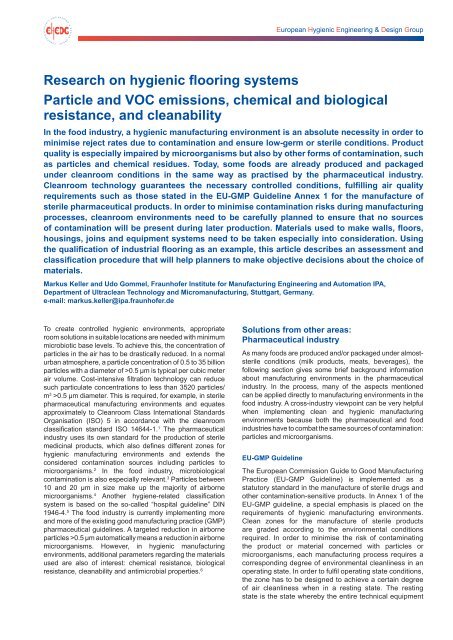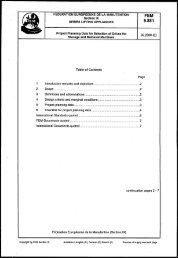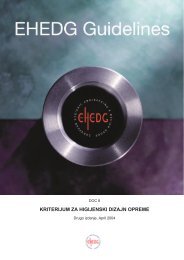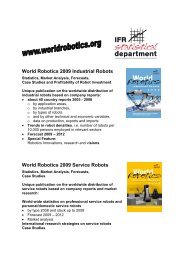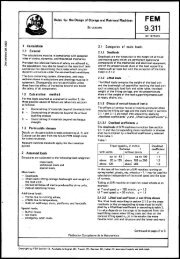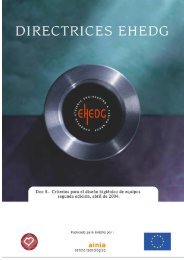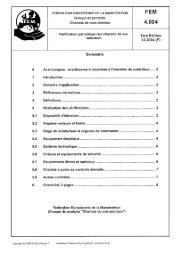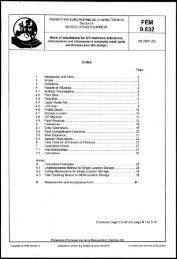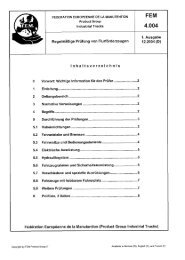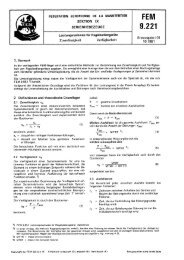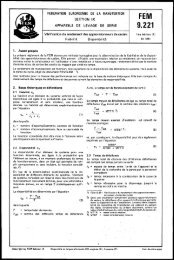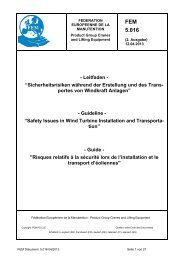to get a complimentary download version - (FKM), Verträge und ...
to get a complimentary download version - (FKM), Verträge und ...
to get a complimentary download version - (FKM), Verträge und ...
Create successful ePaper yourself
Turn your PDF publications into a flip-book with our unique Google optimized e-Paper software.
European Hygienic Engineering & Design GroupResearch on hygienic ooring systemsParticle and C emissions, chemical and biologicalresistance, and cleanabilityIn the food industry, a hygienic manufacturing environment is an absolute necessity in order <strong>to</strong>minimise reject rates due <strong>to</strong> contamination and ensure low-germ or sterile conditions. Productquality is especially impaired by microorganisms but also by other forms of contamination, suchas particles and chemical residues. Today, some foods are already produced and packaged<strong>und</strong>er cleanroom conditions in the same way as practised by the pharmaceutical industry.Cleanroom technology guarantees the necessary controlled conditions, fullling air qualityrequirements such as those stated in the EU-GMP Guideline Annex 1 for the manufacture ofsterile pharmaceutical products. In order <strong>to</strong> minimise contamination risks during manufacturingprocesses, cleanroom environments need <strong>to</strong> be carefully planned <strong>to</strong> ensure that no sourcesof contamination will be present during later production. Materials used <strong>to</strong> make walls, oors,housings, joins and equipment systems need <strong>to</strong> be taken especially in<strong>to</strong> consideration. Usingthe qualication of industrial ooring as an example, this article describes an assessment andclassication procedure that will help planners <strong>to</strong> make objective decisions about the choice ofmaterials.Markus Keller and Udo Gommel, Fraunhofer Institute for Manufacturing Engineering and Au<strong>to</strong>mation IPA,Department of Ultraclean Technology and Micromanufacturing, Stuttgart, Germany.e-mail: markus.keller@ipa.fraunhofer.deTo create controlled hygienic environments, appropriateroom solutions in suitable locations are needed with minimummicrobiotic base levels. To achieve this, the concentration ofparticles in the air has <strong>to</strong> be drastically reduced. In a normalurban atmosphere, a particle concentration of 0.5 <strong>to</strong> 35 billionparticles with a diameter of >0.5 μm is typical per cubic meterair volume. Cost-intensive ltration technology can reducesuch particulate concentrations <strong>to</strong> less than 3520 particles/m 3 >0.5 μm diameter. This is required, for example, in sterilepharmaceutical manufacturing environments and equatesapproximately <strong>to</strong> Cleanroom Class International StandardsOrganisation (ISO) 5 in accordance with the cleanroomclassication standard ISO 14644-1. 1 The pharmaceuticalindustry uses its own standard for the production of sterilemedicinal products, which also denes different zones forhygienic manufacturing environments and extends theconsidered contamination sources including particles <strong>to</strong>microorganisms. 2 In the food industry, microbiologicalcontamination is also especially relevant. 3 Particles between10 and 20 μm in size make up the majority of airbornemicroorganisms. 4 Another hygiene-related classicationsystem is based on the so-called “hospital guideline” DIN1946-4. 5 The food industry is currently implementing moreand more of the existing good manufacturing practice (GMP)pharmaceutical guidelines. A tar<strong>get</strong>ed reduction in airborneparticles >0.5 μm au<strong>to</strong>matically means a reduction in airbornemicroorganisms. However, in hygienic manufacturingenvironments, additional parameters regarding the materialsused are also of interest chemical resistance, biologicalresistance, cleanability and antimicrobial properties. 6Solutions from other areas:Pharmaceutical industryAs many foods are produced and/or packaged <strong>und</strong>er almoststerileconditions (milk products, meats, beverages), thefollowing section gives some brief backgro<strong>und</strong> informationabout manufacturing environments in the pharmaceuticalindustry. In the process, many of the aspects mentionedcan be applied directly <strong>to</strong> manufacturing environments in thefood industry. A cross-industry viewpoint can be very helpfulwhen implementing clean and hygienic manufacturingenvironments because both the pharmaceutical and foodindustries have <strong>to</strong> combat the same sources of contaminationparticles and microorganisms.EU-GMP GuidelineThe European Commission Guide <strong>to</strong> Good ManufacturingPractice (EU-GMP Guideline) is implemented as astatu<strong>to</strong>ry standard in the manufacture of sterile drugs andother contamination-sensitive products. In Annex 1 of theEU-GMP guideline, a special emphasis is placed on therequirements of hygienic manufacturing environments.Clean zones for the manufacture of sterile productsare graded according <strong>to</strong> the environmental conditionsrequired. In order <strong>to</strong> minimise the risk of contaminatingthe product or material concerned with particles ormicroorganisms, each manufacturing process requires acorresponding degree of environmental cleanliness in anoperating state. In order <strong>to</strong> full operating state conditions,the zone has <strong>to</strong> be designed <strong>to</strong> achieve a certain degreeof air cleanliness when in a resting state. The restingstate is the state whereby the entire technical equipment


